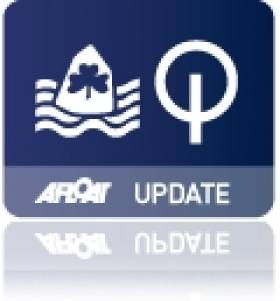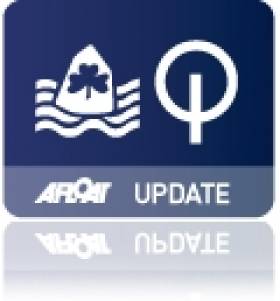Displaying items by tag: Optimist National Championships
Donnelly and Clapp top of Optimist senior and junior ranks
Three races in light north-easterly breezes were completed on the third day of the Image Skincare Irish Optimist Championship at Howth and it’s now a case of Irish boats dominating the senior division and British ones to the fore in the junior ranks.
Peter McCann of Royal Cork, leader after the second day, had the ideal start to the third day with a bullet in the sixth race of the series but that was as good as it got for him. A 20th in the next race and then a retiral meant that the National YC’s Sean Donnelly relegated him to 2nd in the overall standings, thanks to three consistent top 10 results which put the Dun Laoghaire sailor five points clear after one discard.
The second and third races of the day were both won by Kinsale helms, firstly Cliodhna Ni Shuilleabhain and then Sean Gambier-Ross. Significantly, one of the pre-event favourites, Sophie Browne of Tralee, has been steadily moving up the results table and now lies 3rd overall, just seven points off the leader with four races to go.
If the Irish are leading the way in the senior division – and the top three are opening up a large gap on the rest of the 67-boat fleet - only one local entry, Howth’s Ewan McMahon (3rd), is preventing a clean sweep of British boats in the top six of the junior division.
Showing the form that won him the UK Junior title, Max Clapp added two more bullets and a 3rd place to cement his spot at the top of the table. Currently discarding a mere 5th place, the Royal Southern YC 12-year old already has a 23-point margin over his nearest rival, Milo Gill-Taylor from Spinnaker SC.
HYC’s McMahon is a further 12 points adrift and needs to stave off the challenge of the UK’s Benno Marsteller if he is to maintain his drive for a podium finish. The first race of the day, though, was won by an Irish entry, Ronan Cournane of Royal Cork.
Leadership changes at Optimist Nationals after day two
After two more races in the Image Skincare-sponsored Irish Optimist Championships at Howth, there are new leaders in both fleets, with Peter McCann of Royal Cork YC now heading the senior division and UK Junior Champion Max Clapp of Royal Southern YC taking a commanding lead in the junior ranks.
Douglas Elmes of Royal Cork won the first race of the day ahead of Sean Donnelly of the National YC, who took the honours in the second, but it was the consistent McCann – with a 3rd and 2nd – who jumped to the top of the leaderboard.
His cause was helped immensely by a poor day for the overnight leader Adam Hyland (Royal St George YC) with a mid-fleet result and a retiral which drops him to 19th overall.
After a slow start on the first day, Ireland’s World Championship representative Sophie Browne from Tralee Bay SC scored a 7th and 3rd to move up to 4th overall, just a few points behind Skerries’ Sean Waddilove.
Max Clapp demonstrated why he was one of the pre-event favourites for the Junior title by recording two bullets, results which leapfrog him to the top of the table with a massive 24 points margin ahead of another British entry, Benno Marstaller of Restronguet SC.
The early series leader, Howth’s Ewan McMahon, slipped up a little with results in double figures yet remains in 3rd place overall after five races and very much in the frame. Welsh entry Huw Edwards from Port Dinorwic made major ground, jumping from 10th after day one to just behind McMahon.
200 Optimists for Nationals at Howth
200 young Optimist sailors from over 15 Irish clubs (including 24 overseas entries from five other nations) will descend on Howth Yacht Club next week for the Image Skincare Optimist National Championships for a 12-race series over five days.
The bulk of the entries (150) will compete in the main fleet (junior and senior) with the balance in the ‘regatta fleet’ for less experienced sailors. Entries have been received from Britain (including new UK Junior Champion Max Clapp from Royal Southern YC), India, Norway, South Africa and the USA.
After four provincial championships, the Irish senior rankings are led by Tralee’s Sophie Browne who won the Connachts and Munsters and will represent Ireland at the Worlds in New Zealand later this year, having won the IODAI Trials during the Youth Nationals in Dublin Bay.
Adam Hyland (Royal St.George YC), who finished 11th in the recent German Nationals, and Robert Dickson (Howth) are second and third respectively in the rankings while Peter McCann of Royal Cork - 7th overall in the Europeans and a provincial winner too – is another contender.
Two firsts and a second in the provincial events puts Ronan Cournane of Royal Cork on top of the Junior rankings, ahead of Kate Lyttle (Royal St.George YC) and Howth’s Isabelle Delamer.
In the Regatta Fleet, Micheal O’Suilleabhain (Kinsale YC) and Peter Fagan (National YC) are among a small group of sailors who have featured in the top placings at the regional events.
An opening ceremony on Monday (15th) evening at 6.00pm involving all the competitors gets the Nationals underway, with the on-the-water schedule starting on Tuesday 16th with two races. The race management team is led by David Lovegrove, International Race Officer.































































